Syrmia
Syrmia (Serbian: Срем / Srem, Croatian: Srijem) is a fertile region of the Pannonian Plain in Europe, which lies between the Danube and Sava rivers. The majority of Syrmia is located in the Srem and South Bačka districts of the Autonomous Province of Vojvodina in Serbia. A smaller area around Novi Beograd, Zemun, and Surčin belongs to the City of Belgrade. The remaining part of Syrmia is divided between multiple municipalities in Serbia and Vukovar-Srijem County in Croatia.
Contents
1 Etymology
2 Governance
3 History
3.1 Prehistory
3.2 Roman era
3.3 Byzantine era
3.4 Middle Ages
3.5 Early modern period
3.6 19th century
3.7 Recent history
4 Demographics
5 Geography
5.1 Borders
5.2 Bordering regions
5.3 Cities
5.4 Municipalities
5.5 Mountains
6 See also
7 References
8 Sources
Etymology
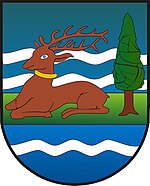
Srem coat of arms
The word "Syrmia" is derived from the ancient city of Sirmium (now Sremska Mitrovica). Sirmium was a Celtic or Illyrian town founded in the third century BC.
Srem in Serbian (Serbian Cyrillic: Срем) and Srijem in Croatian are used to designate the region. Other names for the region include:
Latin: Syrmia or Sirmium
German: Syrmien
Hungarian: Szerémség or Szerém
Slovak: Sriem
Rusyn: Срим
Turkish: Sirem
Ukrainian: Срем, also Срім or Срим
French: Syrmie
Italian: Sirmia
Greek: Syrmia, Σύρμια
Governance

Map of the Syrmia region
Over centuries, Syrmia has been ruled by many different entities. These include the Roman Empire, the Hun Empire, the Ostrogothic Kingdom, the Gepid Kingdom, the Lombard state, the Byzantine Empire, the Avar Khaganate, the Frankish Empire, the Bulgarian Empire, Pannonian Croatia, the Kingdom of Hungary, the Ottoman Empire, the Habsburg Monarchy, the Austrian Empire, Austria-Hungary, the State of Slovenes, Croats and Serbs, the Kingdom of Serbia, the Kingdom of Serbs, Croats and Slovenes, the Kingdom of Yugoslavia, and the Socialist Federal Republic of Yugoslavia. In 1945, on the advice of the Ðilas Commission, the Socialist Federal Republic of Yugoslavia assigned the eastern part of Syrmia to the People's Republic of Serbia and the western part to the People's Republic of Croatia. The westernmost part of Syrmia is in eastern Croatia in Vukovar-Srijem, while the majority of Syrmia is part of Republic of Serbia.
History

Map of Indo-European Vučedol culture centred in Syrmia (3000-2400 BC).

Ancient Indo-European peoples in Syrmia.
Prehistory
Between 3000 BC and 2400 BC, Syrmia was at the centre of Indo-European Vučedol culture.[1]
Roman era

Ancient Roman cities in Syrmia
Sirmium was conquered by Romans in the first century BC and became the economic and political capital of Pannonia. In 6 AD, there was an uprising of the indigenous peoples against Roman rule. However, ten later Roman Emperors were born in Sirmium or nearby. They included Herennius Etruscus (227-251), Hostilian (230?-251), Decius Traian (249-251), Claudius II (268-270), Quintillus (270), Aurelian (270-275), Probus (276-282), Maximianus Herculius (285-310), Constantius II (337-361) and Gratian (367-383). These emperors were mostly Romanised Illyrians.
Byzantine era
In the 6th century AD, Pannonia, was a province of the Byzantine Empire. Through vassal arrangements, Sermia fell under control of various rulers. In the 7th century AD, the ruler of Syrmia was Kuber, a Bulgar leader, who was a vassal of the Avars. In the early 9th century AD, Syrmia was part of the Slavic state of Pannonian Croatia. The ruler, Prince Ljudevit Posavski lost control to the Franks. In 827 AD the Bulgars returned and continued to rule after a peace treaty in 845 AD.
In the 11th century, the ruler of Syrmia was Duke Sermon, vassal of the Bulgarian emperor, Samuil. There had been Bulgar resistance to Byantine rule. This collapsed and Sermon, who refused to capitulate was captured and killed by Constantine Diogenes. A new but ultimately short lived area of governance named the Thema of Sirmium was established. It included the region of Syrmia and what is now Mačva.
Middle Ages
In the 12th century, the region was controlled by the Kingdom of Hungary. On 3 March 1229, the acquisition of Syrmia was confirmed by Papal bull. Pope Gregory IX wrote, "[Margaretha] soror…regis Ungarie [acquired] terram…ulterior Sirmia".[2] In 1231, The Duke of Syrmia was Giletus. In the 1200s, the territory around Syrmia was divided into two counties: Syrmia in the east and Vukovar in the west.
In the 13th century, between 1282 and 1316, Syrmia was ruled by Stefan Dragutin of Serbia.[3][4][unreliable source?] Initially, Dragutin was a vassal of Hungary but later ruled independently. Dragutin died in 1316, and was succeeded by his son, Stefan Vladislav II (1316–1325). In 1324, Vladislav II was defeated by Stefan Uroš III Dečanski of Rascia. Lower Syrmia became the subject of dispute between the Kingdoms of Rascia and Hungary.

Realm of Stefan Dragutin.

Realms of Stefan Dragutin and Ugrin Csák.
In 1404, Sigismund, Holy Roman Emperor ceded part of Syrmia to Stefan Lazarević of Serbia and then to Đurađ Branković.
From 1459, the Hungarian kings endorsed the House of Branković and later, the Berislavići Grabarski family as the titular heads of the Serbian Despotate of which Syrmia was a part. They resided in Kupinik (modern Kupinovo). The local rulers included Vuk Grgurević (1471 to 1485); Đorđe Branković (1486 to 1496), Jovan Branković (1496 to 1502), Ivaniš Berislavić (1504 to 1514), and Stjepan Berislavić (1520 to 1535). In 1522, the last of the titular Serbian despots in Syrmia, Stjepan Berislavić, moved to Slavonia, ahead of invading Ottoman forces. Another important local governor was Laurence of Ilok, Duke of Syrmia (1477 to 1524), who reigned over large parts of the region from Ilok.
Early modern period
In 1521, parts of Syrmia fell to the Ottomans and by 1538, the entire region was under Ottoman control. Between 1527 and 1530, Radoslav Čelnik ruled Syrmia as an Ottoman vassal. The area of Ottoman administration in Syrmia was known as the Sanjak of Syrmia.
In 1699, the Habsburg Monarchy took western Syrmia from the Ottomans as part of the Treaty of Karlowitz.[5] Until the Treaty of Passarowitz at the end of the Austro-Turkish War of 1716-18, remainder of Syrmia was part of the Habsburg Military Frontier.[6] In 1745, the County of Syrmia was established as part of the Habsburg's Kingdom of Slavonia.

Sirmie and Walko counties, 1370

Duchy of Syrmia of Radoslav Čelnik, 1527 to 1530
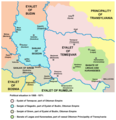
Sanjak of Syrmia, 1568 to 1571

Habsburg-Ottoman frontier in Syrmia, 1699
19th century

Syrmia county, Austria-Hungary, coat of arms
In 1807, the Tican's Rebellion, a Syrmian peasant uprising, occurred on Ruma estate and in the village of Voganj in Ilok estate.
In 1848 and 1849, most of Syrmia was part of the Serbian Voivodship, a Serb autonomous region within the Austrian Empire. From 1849 and 1860, Northern Syrmia, including Ilok and Ruma were part of the Voivodship of Serbia and Tamiš Banat.
After 1860, the County of Syrmia was re-established and returned to the Kingdom of Slavonia. In 1868, the Kingdom of Slavonia became part of Croatia-Slavonia in the Kingdom of Hungary.
Recent history
On 29 October 1918, Syrmia became a part of the newly independent State of Slovenes, Croats and Serbs. On 24 November 1918, the Assembly of Syrmia proclaimed the unification of Serb-populated parts of Syrmia with the Kingdom of Serbia. However, from 1 December 1918, all of Syrmia was made a part of the Kingdom of Serbs, Croats and Slovenes.
From 1918 to 1922, Syrmia remained within the Kingdom of Serbs, Croats and Slovenes and from 1922 to 1929, Syrmia was a province (oblast). In 1929, after a new territorial division, Syrmia was divided between Danube Banovina and Drina Banovina, in the Kingdom of Yugoslavia and in 1931, it was divided between Danube Banovina and Sava Banovina. In 1939, the western part of Syrmia was included into the newly formed Banovina of Croatia.
In 1941, Syrmia was occupied by the World War II Axis powers and its entire territory was ceded to the Independent State of Croatia. In 1945, with the creation of new borders, eastern Syrmia became part of Vojvodina, while western Syrmia became part of Croatia.
In 1991, Croatia declared its independence. Serbs in western Syrmia declared an autonomous region called the "Serbian Autonomous Region of Eastern Slavonia, Baranja and Western Syrmia". This region was one of the two Serbian autonomous regions that formed the Republic of Serbian Krajina. The autonomous regions lasted until 1995.
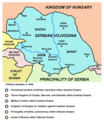
Serbian Voivodship, 1848

The County of Syrmia within Croatia-Slavonia, 1881
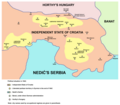
Liberated partisan territory, late 1942

Syrmian frontline prior to April 1945
Demographics

Serb soldier in Syrmia, 1742
In 2002, the population of Syrmia in Serbia was 790,697.[7] 668,745 (84.58%) were Serb. In 2001, the population of the Croatian Vukovar-Srijem county was 204,768.[8] The census showed, that Croats made up 78.3% of total population, Serbs 15.5%, Hungarians 1%, Rusyns 0.9% and others.
Geography
Borders
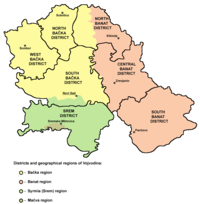
Srem District in Vojvodina.

Vukovar-Srijem county within Croatia.
The present international border of the region of Syrmia was drawn in 1945 by the Đilas commission. It divided the Yugoslav constituent republic of Croatia and the Autonomous Province of Vojvodina, itself part of Serbia, within Yugoslavia.
Milovan Đilas, a Montenegrin and then a confidante of Josip Broz Tito, drew the border according to demographic criteria, which explains why the Croatian town of Ilok on the Danube, with a Croat majority, lies east of Šid in Serbia, with a Serb majority. The border drawn in 1945 was very similar to the 1931-1939 border between the Danube Banovina and the Sava Banovina within the Kingdom of Yugoslavia.
Bordering regions
Bačka to the north
Banat to the east
Šumadija the south-east
Mačva to the south
Semberija to the south-west
Slavonia to the west. The border between Syrmia and Slavonia is unclear. It runs approximately along a line through Vukovar, Vinkovci, and Županja or it follows the Bosut, Barica and Vuka rivers.
Cities

Map showing cities and towns in Serbian part of Syrmia.
List of cities in Syrmia (with population):
Serbia
Belgrade city region
Novi Beograd (217,180)
Zemun (146,172)
Batajnica (48,600)
Surčin (14,209)
Dobanovci (8,114)
Vojvodina
Sremska Mitrovica (39,041)
Ruma (32,125)
Inđija (26,244)
Stara Pazova (18,628)
Šid (16,301)
Petrovaradin (13,917)
Sremska Kamenica (11,140)
Sremski Karlovci (8,839)
Beočin (8,037)
Irig (4,854)
Croatia
Vinkovci (33,239)
Vukovar (30,126)
Županja (13,775)
Ilok (5,897)
Petrovaradin, Sremska Kamenica, Sremski Karlovci and Beočin are geographically located in Syrmia, but they are part of South Bačka District.
Municipalities
Municipalities in Serbian Syrmia:
- Šid
- Sremska Mitrovica
- Irig
- Ruma
- Inđija
- Stara Pazova
- Pećinci
- Novi Beograd
- Zemun
- Surčin
- Sremski Karlovci
- Petrovaradin
- Beočin
The Syrmian villages of Neštin and Vizić are part of the municipality of Bačka Palanka, the main part of which is in Bačka. Several settlements that are part of the municipality of Sremska Mitrovica are located in Syrmia in Mačva.
Municipalities and villages in Croatian Syrmia:
- Vukovar
- Ilok
- Vinkovci
- Županja
- Otok
- Trpinja
- Borovo
- Tordinci
- Markušica
- Jarmina
- Ivankovo
- Vođinci
- Stari Mikanovci
- Babina Greda
- Cerna
- Gradište
- Andrijaševci
- Privlaka
- Bošnjaci
- Drenovci
- Gunja
- Vrbanja
- Nijemci
- Tovarnik
- Lovas
- Tompojevci
- Stari Jankovci
- Negoslavci
- Bogdanovci
- Nuštar
Mountains
Syrmia's principal mountain is Fruška Gora. Its highest peak is Crveni Čot at 539 m.
See also
- Srem District
- Methodius Stratiev
- Vukovar-Srijem County
- Syrmia County
- Sanjak of Syrmia
- Kingdom of Srem
- Theme of Sirmium
- Sirmium
- Vojvodina
- Slavonia
- Serbian Orthodox Eparchy of Srem
- Roman Catholic Diocese of Srijem
References
^ Syrmia[permanent dead link], vjesnik.hr; accessed 13 April 2015.
^ "Margit of Hungary" FMG Accessed 13 April 2015.
^ Veselinović R. Istorija Srpske pravoslavne crkve sa narodnom istorijom I Belgrade, 1969. p18.
^ Grujić R. Pravoslavna Srpska crkva, Kragujevac, 1989, p22.
^ Stoye J. Marsigli's Europe, 1680-1730 Yale University Press, 1994 p185 .mw-parser-output cite.citation{font-style:inherit}.mw-parser-output q{quotes:"""""""'""'"}.mw-parser-output code.cs1-code{color:inherit;background:inherit;border:inherit;padding:inherit}.mw-parser-output .cs1-lock-free a{background:url("//upload.wikimedia.org/wikipedia/commons/thumb/6/65/Lock-green.svg/9px-Lock-green.svg.png")no-repeat;background-position:right .1em center}.mw-parser-output .cs1-lock-limited a,.mw-parser-output .cs1-lock-registration a{background:url("//upload.wikimedia.org/wikipedia/commons/thumb/d/d6/Lock-gray-alt-2.svg/9px-Lock-gray-alt-2.svg.png")no-repeat;background-position:right .1em center}.mw-parser-output .cs1-lock-subscription a{background:url("//upload.wikimedia.org/wikipedia/commons/thumb/a/aa/Lock-red-alt-2.svg/9px-Lock-red-alt-2.svg.png")no-repeat;background-position:right .1em center}.mw-parser-output .cs1-subscription,.mw-parser-output .cs1-registration{color:#555}.mw-parser-output .cs1-subscription span,.mw-parser-output .cs1-registration span{border-bottom:1px dotted;cursor:help}.mw-parser-output .cs1-hidden-error{display:none;font-size:100%}.mw-parser-output .cs1-visible-error{font-size:100%}.mw-parser-output .cs1-subscription,.mw-parser-output .cs1-registration,.mw-parser-output .cs1-format{font-size:95%}.mw-parser-output .cs1-kern-left,.mw-parser-output .cs1-kern-wl-left{padding-left:0.2em}.mw-parser-output .cs1-kern-right,.mw-parser-output .cs1-kern-wl-right{padding-right:0.2em}
ISBN 0300055420, 9780300055429 Accessed at Google Books 3 August 2016.
^ Ingrao, Samardžić & Pešalj 2011, p. 193.
^ Popis stanovništva, domaćinstava i stanova 2002. Knjiga 1: Nacionalna ili etnička pripadnost po naseljima. Srbija, Republički zavod za statistiku Beograd 2003;
ISBN 86-84433-51-3
^ Census Archived 2006-05-01 at the Wayback Machine.
Sources
Mih. J. Miladinović (1903). Istorija Srema. Štamp. D. Dimitrijevića.
Miladinovi J (December 2013). Istorija Srema. HardPress. ISBN 978-1-314-69554-0.
Petar Milošević (1981). Srem u prošlosti. Novinsko-izdavačka radna organizacija "Sremske novine.".
Žarko Atanacković (1968). Srem u narodnooslobodilačkom ratu i socijalističkoj revoluciji. Šimanovci, Mesna zajednica-Mesni odbor SUB NOR-a.
Đorđe Cvejić; Jovan Babović; Miodrag Živković (1982). Srem u samoupravnoj socijalističkoj Jugoslaviji 1945-1981. NIO Poslovna politika.
Slavko Gavrilović (1979). Srem od kraja XVII do sredine XVIII veka. Filozofski fakultet u Novom Sadu, Institut za istoriju.
Mihailo Dinić. Sredjnevekovni Srem.
Миодраг Матицки (2007). Срем кроз векове: слојеви култура Фрушке горе и Срема : зборник радова. Вукова Задужбина. ISBN 978-86-902961-5-6.
Слободан Ћурчић (2012). Атлас насеља Војводине: Срем. Матица српска. ISBN 978-86-7946-108-7.
Fodor, Pál; Dávid, Géza, eds. (2000). Ottomans, Hungarians, and Habsburgs in Central Europe: The Military Confines in the Era of Ottoman Conquest. BRILL.
Ingrao, Charles; Samardžić, Nikola; Pešalj, Jovan, eds. (2011). The Peace of Passarowitz, 1718. West Lafayette: Purdue University Press.
Coordinates: 45°10′12″N 19°17′17″E / 45.170°N 19.288°E / 45.170; 19.288
| Wikimedia Commons has media related to Syrmia. |










